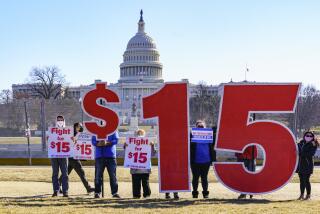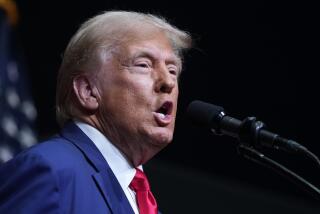Obama speech highlights gap between his goals and his resources
WASHINGTON — President Obama’s sixth speech on the state of the union spotlighted many issues, but more than anything it illuminated the vast gap between his policy ambitions and the tools he has to achieve them.
The president made the ambition clear last month, when he referred to a “dangerous and growing inequality and lack of upward mobility” in the U.S. as the “the defining challenge of our time,” a theme he repeated Tuesday night.
“After four years of economic growth, corporate profits and stock prices have rarely been higher, and those at the top have never done better,” he said, “but average wages have barely budged. Inequality has deepened.”
Framing the issue primarily around the lack of progress for working Americans, rather than the outsized gains of the wealthiest, matters politically because convincing the public to focus on the issue makes up Obama’s first challenge. So far, Americans have expressed mixed reactions to talk of income inequality, polls by several major organizations have shown.
INTERACTIVE: Obama’s choice of words
Large majorities of Americans — 60% in a recent Pew Research Center survey — say they believe the “economic system in this country unfairly favors the wealthy,” and even more agreed that the gap between the rich and everyone else had grown significantly. But only a minority, 45%, believe that “reducing income inequality between the rich and poor” is an “absolute priority” that Congress and the president need to address this year, according to a Wall Street Journal/NBC poll released Tuesday.
Perhaps with that ambivalence in mind, Obama has moved away from the most direct method of reducing the income gap. In sharp contrast with previous State of the Union speeches, he did not renew his call for further increases in income tax rates on top earners.
Instead, Obama emphasized a collection of policies that he and his advisors hope can ultimately boost incomes for those in the bottom and middle.
But the very fact that wage stagnation and income inequality have worsened for nearly four decades — through the presidencies of four Republican and three Democratic presidents — shows the difficulty of the task Obama would like to take on. To accomplish it, he has limited options.
One highlight of his speech, the announcement of an executive order to raise the minimum wage for companies doing business with the government, illustrates the point. The order exemplifies the sort of executive action that Obama hopes to do more of this year to move his agenda forward despite dug-in Republican opposition in Congress.
The order would raise wages over the next several years for an undetermined number of low-wage workers, perhaps several hundred thousand, including janitors in federal buildings and servers in their cafeterias. But the move necessarily would leave untouched the pay of millions of other low-wage workers whose jobs are not tied to federal contracts. Raising the minimum wage for that larger group would require Congress to act.
Some Democrats hope election year political pressure will cause Republican leaders to go along with a minimum wage bill, although both House Speaker John A. Boehner of Ohio and Senate Minority Leader Mitch McConnell of Kentucky denounced the idea Tuesday.
Even if Congress were to pass a bill, however, the increase to $10.10 per hour that the administration has backed would directly affect about 6% of the nation’s hourly wage earners who currently make less.
QUIZ: Test your State of the Union knowledge
Economists sympathetic to the administration support such an increase but concede it would not, by itself, turn around the trend toward greater inequality.
The same goes for other policies Obama mentioned — and which Republicans are likely to continue to oppose — including extension of unemployment benefits for those who have been out of a job for more than 26 weeks and expansion of pre-kindergarten education.
“There’s certainly no silver bullet that by itself will bring the levels of inequality back to where they were decades ago,” said Jared Bernstein, a former Obama administration economic advisor now at the Center on Budget and Policy Priorities in Washington.
“It’s challenging with a cooperative Congress,” Bernstein added. “With a gridlocked one,” a president can mostly “nibble at the margins.”
The fundamental problem is that for all the attention given to the economic records of presidents, they have limited ability to shape how the economy acts, particularly in the short term. Programs like expanded preschool might deliver the benefits that Obama and his allies hope. But if so, the payoff would come years down the road.
The policy outcome that would do the most to advance Obama’s goal of raising incomes for American workers is the one that has proved most elusive throughout his tenure: robust economic growth. That was the lesson of the late 1990s, when tight labor markets gave employees more bargaining power with their bosses and led to a brief spate of rising incomes for a majority of working Americans.
State of the Union: 15 historic moments
President Clinton won strong approval ratings in the final years of his term in large part because of those rising incomes. But while Clinton’s policies may have played a role in that economic growth, luck played the larger share. Much the same was true for Ronald Reagan. Both presidents experienced short, sharp recessions early on and enjoyed the upswing of the business cycle later.
The same could yet prove true for Obama if the economy continues to improve. But if it does not, he at least appears to have grown more philosophical about the limits he faces.
“One of the things that I’ve learned to appreciate more as president is you are essentially a relay swimmer in a river full of rapids, and that river is history,” he told New Yorker editor David Remnick in a recent interview. “You don’t start with a clean slate, and the things you start may not come to full fruition on your timetable. But you can move things forward.”
Twitter: @davidlauter
More to Read
Sign up for Essential California
The most important California stories and recommendations in your inbox every morning.
You may occasionally receive promotional content from the Los Angeles Times.











